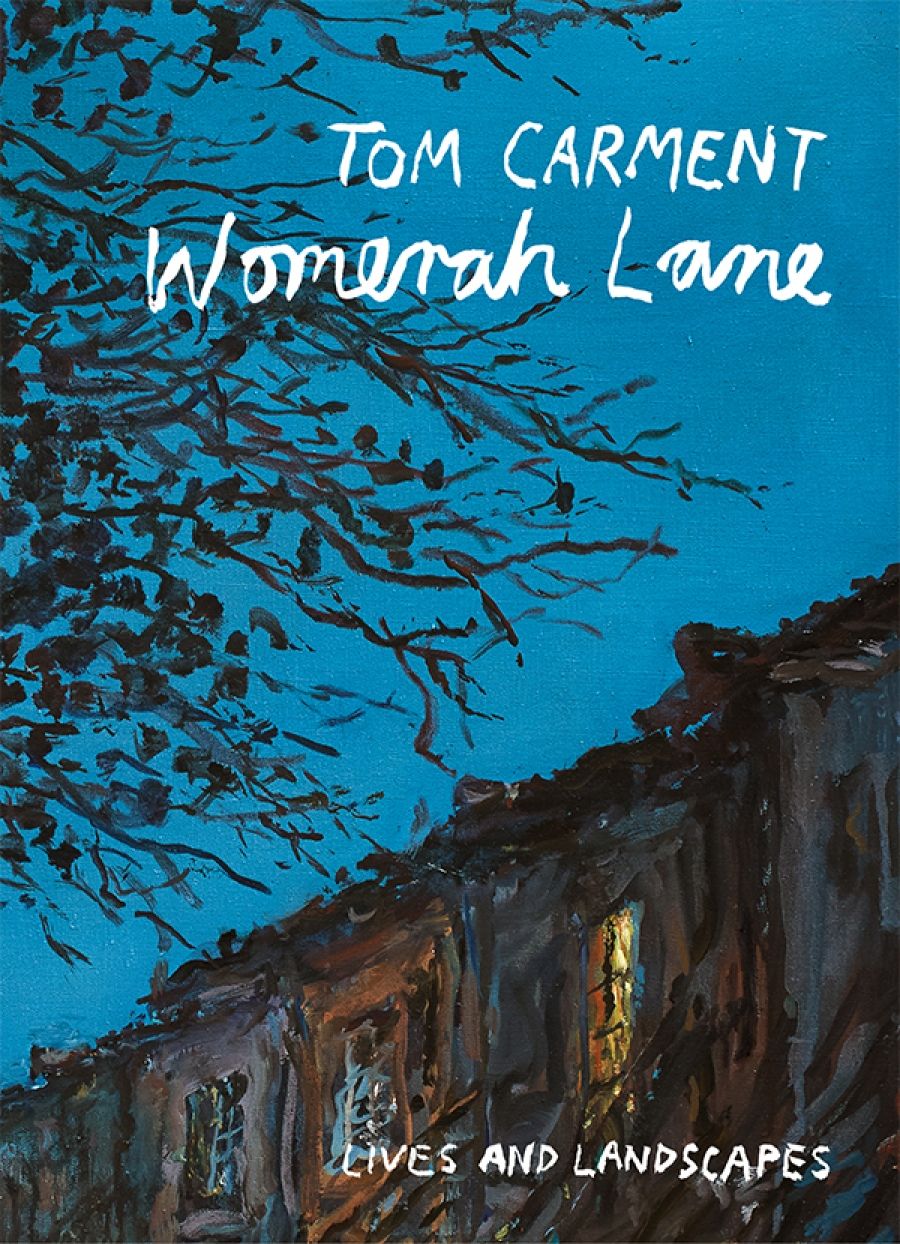
- Free Article: No
- Contents Category: Essay Collection
- Review Article: Yes
- Online Only: No
- Custom Highlight Text:
Tom Carment the artist, writer, and man makes a perfectly integrated whole. Carment is a compact, casually neat figure who looks through round-lensed glasses and has a calm stillness even when he’s on the move, as he often is. His art and writing are also on a small scale, intimately observant, informal, and warmly appealing. He has exhibited his paintings and drawings for more than four decades and has written for almost as long, occasionally for publication and often in private. As he said at his book launch, he used to pour most of his thoughts into letters, including one he found recently that ran to thirty-eight pages.
- Grid Image (300px * 250px):

- Book 1 Title: Womerah Lane
- Book 1 Subtitle: Lives and landscapes
- Book 1 Biblio: Giramondo, $39.95 pb, 261 pp, 9781925818215
Womerah Lane gathers more than forty ‘essays, non-fiction stories and vignettes’ written over three decades. As a collection, they create a loose memoir of Carment’s life, but chronology is less important than themes of place, history, community, relationships, memory, and art itself. The unhurried pace invites readers to dip in rather than hurry through.
Carment gives a modest summary of the subjects covered: ‘swimming, drawing, Albert Namatjira, art supplies, friends who’ve died, long journeys, the Easter Show, the Opera House, rabbit-rearing, sheep-rearing, hitchhiking, water-divining, long-distance cycling, building construction, and even … my love of telegraph poles, typewriters and eggs.’
Carment has lived in Sydney for most of his life; Womerah Lane is his family’s long-time address in inner-urban Darlinghurst. His opening essay describes without judgement the goings-on in the lane, from drug deals and prostitution to children in paddle pools. Carment observes his neighbours with clear-eyed affection. There’s the retired head of the Seamen’s Union whose portrait he painted four times; a man who played Barbra Streisand records loudly every day and shouted at Carment’s daughter, the only time the mild-mannered artist shouted back; a homeless man who slept under houses and promptly slipped a two-dollar coin under the gate to repay Carment’s loan.
 Tom Carment (photograph by Tiger Webb)
Tom Carment (photograph by Tiger Webb)
Throughout the book, Carment’s gentle stories are yeasted with odd details and well-timed humour. The funniest recurring motif, though perhaps not for Carment at the time, is the trouble his unthreatening presence attracts. As a plein-air painter, he works on location and quickly, but not quickly enough to escape attention. People think he’s suicidal, selling drugs, or writing parking tickets; police question him; strangers chat and ask for money; a cow nudges him with its wet nose; a dog lifts its leg on his back. He’s always polite but sometimes shaken.
Almost every story, no matter the ostensible topic, is about Carment’s artistic life. Alongside the words run finely reproduced works of art he created in that place: impressionistic oils, luminous watercolours, sketchy pencil and charcoal drawings capturing both snapshot moments and movement in their shimmering lines.
From his city base, he travels the Australian continent from Queensland to Western Australia to visit friends, seek adventure, and find new locations. There are family camping holidays to the beach, working visits to country properties, cycling trips, hitchhiking, and solitary walks in the bush, always with his portable studio of paints, panels, and folding stool. Carment is a curious reporter, recording dates and arcane facts, enhanced by the artist’s dash. He remembers the brand and variety of a cat food can stuck on a lizard’s head, sees sleeping passengers on a train as ‘plaster casts of Pompeii victims’, and notes that Grafton Anglican Cathedral is built with half a million pink sandstock bricks. The long chapter on Cooktown is a profound nugget of Australian history.
Perhaps the greatest distinction between his visual and written records is that the painted scenes are empty of people, or at most show a few vaguely outlined figures, while the stories are alive with colourful characters and conversations. On his travels, he meets truck drivers, farmers, and waitresses; he’s at home with old-timers, though his antenna twitches at the ingrained prejudices he sometimes encounters.
Carment’s wide network includes artists such as Brett and Wendy Whiteley, and writers David Malouf, Robert Gray, and Gillian Mears, whose unpredictable life he recalls through their letters. His fine account of helping to dismantle the studio of photographer Olive Cotton is quoted at length in Helen Ennis’s new biography (reviewed on page 23). This story, like most, ends delicately: ‘The next day, Olive gave me a print of a gum tree against the sky. The signature is unsteady and there are white hairs on the darks, but I like it for that.’
Accidents, illness, and deaths accumulate. The tone becomes gradually elegiac as he writes about late friends and his father, a survivor of Changi, Sandakan, and Kuching, who sat for his son four times, occasions Carment remembers as some of their most meaningful and relaxed together. His word portraits are created with the same steady gaze as the painted ones, which have often been hung in the Archibald Prize.
There is fascinating expertise in Carment’s chapters, specifically on his methods, materials, and influences from Caspar David Friedrich to Edward Hopper and Albert Namatjira. He came to still-life painting late, at the age of sixty, inspired by the red onions in a Velázquez painting. Even then his partner, Jan, suggested that he should wait until he was too decrepit to leave the house.
In his sixties, Tom Carment remains ageless and energetic, exhibiting regularly, his style little changed but always fresh. This beautifully written, illustrated, and produced book enlarges our vision of Australia through the highlights of a distinctive and inspiring career.


Comments powered by CComment